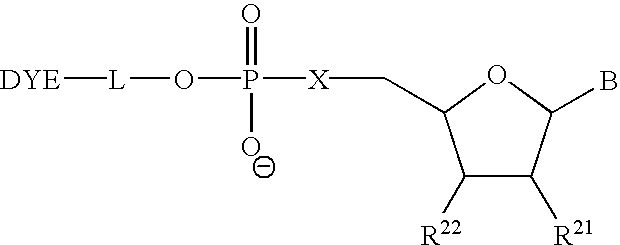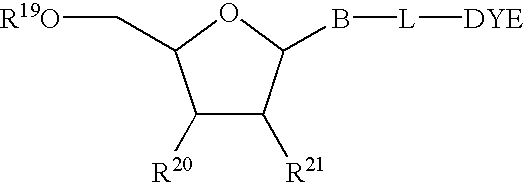Multipartite high-affinity nucleic acid probes
a nucleic acid probe and high-affinity technology, applied in the field of nucleic acid analogs and hybridization, can solve the problems of custom synthesis of oligonucleotides, high cost and time-consuming, and further delay in nucleic acid analysis, and achieve the effect of accurate determination
- Summary
- Abstract
- Description
- Claims
- Application Information
AI Technical Summary
Benefits of technology
Problems solved by technology
Method used
Image
Examples
example 1
Synthesis of Probes
PNA probes may be synthesized at any scale from commercially available reagents and automated synthesizers, following the manufacturers' protocols. Most conveniently, PNA is synthesized at the 2 .mu.mole scale, using Fmoc / Bhoc, tBoc / Z, or MMT protecting group monomers on an Expedite Synthesizer (PE Biosystems) on XAL or PAL support, on the Model 433A Synthesizer (PE Biosystems) on MBHA support, or on other automated synthesizers. After synthesis is complete, the crude PNA is cleaved from the support, e.g. with trifluoroacetic acid, and then precipitated with diethylether and washed twice in diethylether. PNA may be purified by reverse-phase HPLC, analyzed by mass spectroscopy, and quantitated by correlating absorbance at 260 nm with mass.
Oligonucleotide probes may be synthesized from commercially available (PE Biosystems) nucleoside phosphoramidites (U.S. Pat. No. 4,415,732) and solid supports, e.g. silica, controlled-pore-glass (U.S. Pat. No. 4,458,066) and polys...
example 2
Detection of a Target Nucleic Acid
PNA can hybridize to its target complement in either a parallel or anti-parallel orientation. However, the anti-parallel duplex (where the carboxyl terminus of PNA is aligned with the 5' terminus of DNA, and the amino terminus of PNA is aligned with the 3' terminus of DNA) is typically more stable (Egholm, etal (1993) "PNA hybridizes to complementary oligonucleotides obeying the Watson-Crick hydrogen bonding rules", Nature 365:566-68). The PNA FRET probes of the present invention are designed such that the PNA anneals in the anti-parallel orientation with the target sequences.
PNA molecules ME01 and ME02 were combined with DNA molecule 1057 as a model target:
GGGCTGGGGCTGGGCAG (SEQ ID NO:1)
in 50 .mu.L of 100 mM Tris-HCl, pH 8 to form the three-way junction shown in FIG. 7. The final concentration of each PNA and DNA molecule was 1 .mu.M. The mixtures were incubated at 95.degree. C. for 10 minutes and gradually cooled to 37.degree. C. over one hour in ...
example 3
Specificity of the Complex
PNA molecules ME01 and ME02 were combined either with the complementary DNA molecule 1057, as above, or with DNA molecule 1058:
GGGCTGCCCTTTCTGGGCAG (SEQ ID NO. 2)
which bears a three nucleotide insertion (mut3bp) when compared to 1057, or with DNA molecule 1059:
GGGCTCGGGCTGGGCAG (SEQ ID NO. 3)
which bears a single nucleotide substitution (mut1bp). Annealing, electrophoresis and detection were carried out as described in Example 2. Under native conditions, three-way junction complexes were formed for each DNA (FIG. 8, lanes 1-3). Under denaturing conditions (FIG. 9), although the PNA-PNA-DNA complex was clearly evident when the complementary target sequence of 1057 was present (lane 1), no stable complex formation was observed in the presence of the mismatch of 1059 (lane 2) or in the presence of the three nucleotide insertion of 1058 (lane 3). The specificity of two PNA probes each with 7 base first portions hybridizing to target and 8 base second portions hy...
PUM
| Property | Measurement | Unit |
|---|---|---|
| pH | aaaaa | aaaaa |
| v/v | aaaaa | aaaaa |
| concentration | aaaaa | aaaaa |
Abstract
Description
Claims
Application Information
 Login to View More
Login to View More - R&D
- Intellectual Property
- Life Sciences
- Materials
- Tech Scout
- Unparalleled Data Quality
- Higher Quality Content
- 60% Fewer Hallucinations
Browse by: Latest US Patents, China's latest patents, Technical Efficacy Thesaurus, Application Domain, Technology Topic, Popular Technical Reports.
© 2025 PatSnap. All rights reserved.Legal|Privacy policy|Modern Slavery Act Transparency Statement|Sitemap|About US| Contact US: help@patsnap.com



